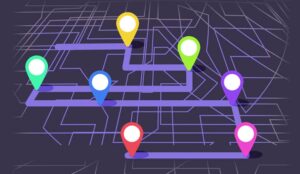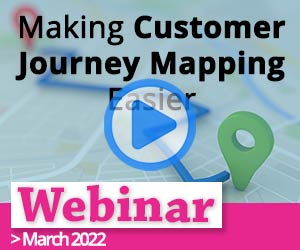Our panel of experts share their favourite examples of tools and techniques to improve your customer journey mapping initiatives.
1. Customer Personas
Including this human element is important at every stage of customer journey mapping.
Customer segmentation is a tried-and-tested technique to divide up your customer base. This is important because not everyone has the same journey.
You then build personas to represent each segment and take them under careful consideration when designing your customer journey maps.
By doing this, you gain insight into the emotional experience, as well as the functional experience, of each of your key customer groups, as they move along the customer journey.

Richard Pinnington
Including this human element is important at every stage of customer journey mapping. So, try to create these personas, use analytics tools and also engage with your contact centre team.
But don’t just talk to your team about the pain points in customer journeys, ask the frontline staff to share customer success stories with other departments to improve best-practice learning across the entire organization.
Thanks to Richard Pinnington at Calabrio
2. Spreadsheets and Flowcharts
Customer journey maps can take different forms. For example, they might be swim lanes on a spreadsheet or a flowchart. There isn’t any right or wrong format.
Customer journey maps can take different forms. For example, they might be swim lanes on a spreadsheet or a flowchart. There isn’t any right or wrong format.
However, you need something that depicts every touchpoint across the journey and fully conveys the experience from the customer’s viewpoint.
Such a framework would pinpoint key areas of friction, including rough transitions between channels, barriers to making purchases and poor experiences in specific touchpoints. You can discover these pain points through customer research.

Shawna Malecki
This research should include structured data – collected through operational reporting, self-service analytics and multiple-choice customer surveys, as well as unstructured data – gathered through call recordings, interaction analytics and open-ended customer surveys.
These tools let you see all the high and low points – in terms of customer satisfaction, sentiment and effort – along the journey path.
Thanks to Shawna Malecki at NICE inContact
You can find out more about journey maps by reading our article: 5 Steps to Creating a Customer Journey Map
3. Visualization, Collaboration and Monitoring
The most effective journey mapping solutions allow organizations not only to capture raw information for mapping purposes but also to group that information for analysis.
To do this, organizations should focus on the following three key techniques that improve customer journey mapping and customer experience.

Frank Sherlock
- Visualization: This allows you to create graphical representations of a customer’s journey. Visualization features should offer multiple prebuilt diagrams and templates, as well as a toolset for customizing journey maps to fit your own business goals.
- Collaboration: Team members should be involved in the mapping process to share information, update conceptual details and work together from separate work environments. This shared environment enables your business to collaborate effectively.
- Monitoring: By capturing critical customer data through other tools, such as customer satisfaction analytics, customer experience monitoring, customer surveys and more, businesses can better understand the voice of their customer and customer emotion. Doing this creates better-informed journey maps.
Thanks to Frank Sherlock at CallMiner
4. Pool Your Data Together
To ensure success, you should always keep in mind that customer journey mapping is an activity that requires close collaboration between multiple parts of an organization.
By collaborating you can start to eliminate data silos that can cause the customer journey to break down.
By collaborating you can start to eliminate data silos that can cause the customer journey to break down. To eliminate these silos, pool information from online activities, social media and customer history, while also encouraging a culture of open data sharing.

Jason Mitchell
Combined with collaboration across your organization, the techniques and tools listed in the following four-step approach will manifest into successful customer journeys.
- Analyse existing traffic and identify your key customer journeys.
- Test whether your templates match what your customers actually do.
- Use speech analytics to understand what your customers said and then did.
- Draw all your data together to gain a clear picture of where customer journeys are flowing and where they start to go wrong.
Thanks to Jason Mitchell at Odigo
5. “Macro” and “Micro” Planning
The macro journey starts with the first interaction between a customer and your organization.
The macro journey starts with the first interaction between a customer and your organization – possibly in response to an advert or an internet search. This then continues through the processes of purchasing, obtaining ongoing customer service, upgrading to new products and services, etc.
The key purpose of customer journey planning at a macro level is to avoid issues arising in the first instance and, if an issue does occur, to ensure that issue doesn’t turn into a problem.
A micro journey is a more detailed view of any of these steps, such as the resolution of a particular customer issue, which may involve multiple interactions over multiple channels.

Matt Bourke
When a specific query is raised, ensure service teams set clear expectations as to what that customer journey will look like, allowing customers to track the progress of their query and self-serve wherever possible.
By considering both the macro and the micro journey, service interactions won’t appear as an afterthought. They will be an integral part of the service experience, from the very first time a prospect makes contact.
Thanks to Matt Bourke at Sensée
6. Listen to the Voice of the Contact Centre
When leading a customer journey session, get the right people in the room, listen to every perspective and discuss a pre-prepared analysis of pain points.
When leading a customer journey session, get the right people in the room, listen to every perspective and discuss a pre-prepared analysis of pain points.
When it comes to collecting data around these pain points, do your groundwork and consider gathering data from focus groups, social listening and customer complaints.

Ben Goodey
Such groundwork should also include the perspectives of contact centre advisors, who see the problems facing customers every single day.
An advisor can likely tell you five things wrong with a process they’re involved in right off the bat, which you can then analyse further.
Thanks to Ben Goodey at SentiSum
7. Voice of the Customer (VoC) Analytics
A useful customer journey mapping technique is being able to capture bundles of information by using tools such as VoC analytics.
Such a tool allows organizations to capture raw data for customer journey mapping purposes, which can drive decisions in every department.
These departments may include product management and operations, as well as marketing and sales, who can use this data to remove pain points. This will not only improve customer experience but also reduce call volumes into the contact centre.

Alex Stenton-Hibbert
Also, through analysing VoC data, common themes and topics will emerge within your customer journey. You may also see the sentiment expressed towards each stage of the journey.
Of course, some insights will be expected, but others may be unexpected, helping you fix broken processes within the customer journey which you might not have spotted before.
Thanks to Alex Stenton-Hibbert at Business Systems
8. AI Integrations
Value can be maximized through AI integrations with a speech analytics system
Mining through data, before customer journey mapping begins, improves the value and efficiency of your sessions, as you come armed with lots of valuable information.

Philip Stanfield
The extent of this value can be maximized through AI integrations with a speech analytics system, which can be used to learn and recognize interactions that will lead to positive customer experience outcomes. You can then build this into your maps.
Also, AI can help to capture data from customer interactions, which enables you to build preferences and profiles of customers. This allows for a structured analysis of your customer base.
Thanks to Philip Stanfield at Aspect
For more customer journey and experience advice from our panel of experts, read our articles:
– Worst Mistakes to Avoid… Mapping the Customer Journey
– 30 Customer Experience Trends to Watch Out For
– 20 Things Advisors Can Do to Improve the Customer Experience
Author: Robyn Coppell
Published On: 17th May 2021 - Last modified: 6th Sep 2024
Read more about - Call Centre Management, Alex Stenton-Hibbert, Alvaria, Business Systems, Calabrio, CallMiner, Customer Journey, Frank Sherlock, NICE CXone, Odigo, Sensee


















